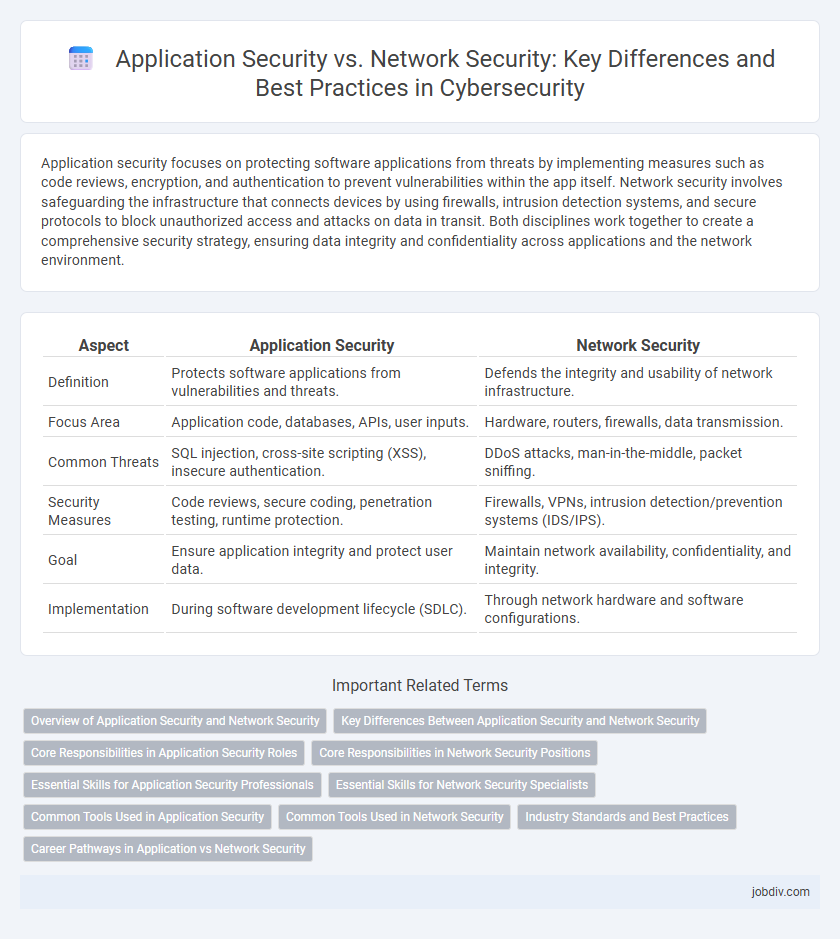Application security focuses on protecting software applications from threats by implementing measures such as code reviews, encryption, and authentication to prevent vulnerabilities within the app itself. Network security involves safeguarding the infrastructure that connects devices by using firewalls, intrusion detection systems, and secure protocols to block unauthorized access and attacks on data in transit. Both disciplines work together to create a comprehensive security strategy, ensuring data integrity and confidentiality across applications and the network environment.
Table of Comparison
| Aspect | Application Security | Network Security |
|---|---|---|
| Definition | Protects software applications from vulnerabilities and threats. | Defends the integrity and usability of network infrastructure. |
| Focus Area | Application code, databases, APIs, user inputs. | Hardware, routers, firewalls, data transmission. |
| Common Threats | SQL injection, cross-site scripting (XSS), insecure authentication. | DDoS attacks, man-in-the-middle, packet sniffing. |
| Security Measures | Code reviews, secure coding, penetration testing, runtime protection. | Firewalls, VPNs, intrusion detection/prevention systems (IDS/IPS). |
| Goal | Ensure application integrity and protect user data. | Maintain network availability, confidentiality, and integrity. |
| Implementation | During software development lifecycle (SDLC). | Through network hardware and software configurations. |
Overview of Application Security and Network Security
Application security involves protecting software applications from vulnerabilities and attacks by implementing measures such as secure coding practices, application firewalls, and regular vulnerability assessments. Network security focuses on safeguarding the integrity, confidentiality, and availability of data transmitted across or stored in network infrastructures using technologies like firewalls, intrusion detection systems, and encryption protocols. Both domains aim to prevent unauthorized access and data breaches, but application security targets specific software layers while network security protects the broader communication environment.
Key Differences Between Application Security and Network Security
Application security focuses on protecting software applications from vulnerabilities and attacks such as code injection, cross-site scripting, and data breaches by implementing secure coding practices, regular testing, and patch management. Network security aims to safeguard the integrity, confidentiality, and availability of data as it is transmitted across or accessed through network infrastructures using firewalls, intrusion detection systems, and encryption protocols. The key difference lies in application security targeting the software layer specifically, while network security provides a broader defense for the entire data communication environment.
Core Responsibilities in Application Security Roles
Application security roles focus on identifying and mitigating vulnerabilities within software through code reviews, security testing, and implementing secure development practices. Core responsibilities include threat modeling, vulnerability assessments, and integrating security tools within the DevSecOps pipeline to protect applications from exploits. These roles prioritize safeguarding application data, user authentication mechanisms, and preventing attacks such as SQL injection and cross-site scripting.
Core Responsibilities in Network Security Positions
Network security professionals focus on safeguarding the integrity, confidentiality, and availability of data transmitted across networks by implementing firewalls, intrusion detection systems, and secure communication protocols. They manage access controls, monitor network traffic for suspicious activities, and respond to cyber threats to prevent unauthorized access and data breaches. Their core responsibilities also include maintaining VPNs, updating security policies, and ensuring compliance with industry standards such as ISO/IEC 27001 and NIST frameworks.
Essential Skills for Application Security Professionals
Application security professionals must possess expertise in secure coding practices, threat modeling, and vulnerability assessment to protect software from attacks. Proficiency in tools such as static and dynamic analysis, along with familiarity with frameworks like OWASP Top Ten, is crucial for identifying and mitigating application vulnerabilities. Strong knowledge of authentication protocols, encryption methods, and incident response prepares these professionals to safeguard applications throughout the software development lifecycle.
Essential Skills for Network Security Specialists
Network Security Specialists must master firewall configuration, intrusion detection systems (IDS), and secure VPN implementation to protect data transmission and prevent unauthorized access. Proficiency in threat analysis, vulnerability assessment, and network protocol understanding, such as TCP/IP and DNS, is critical for identifying and mitigating security risks. Skills in incident response, security information and event management (SIEM) tools, and encryption technologies further enhance a network specialist's ability to safeguard organizational infrastructure.
Common Tools Used in Application Security
Common tools used in application security include static application security testing (SAST) tools, dynamic application security testing (DAST) tools, and interactive application security testing (IAST) tools. These tools help identify vulnerabilities in source code, runtime behavior, and during application execution to prevent exploits. Web application firewalls (WAFs) and software composition analysis (SCA) tools also play crucial roles in protecting applications from attacks and managing open-source component risks.
Common Tools Used in Network Security
Network security employs tools such as firewalls, intrusion detection systems (IDS), and virtual private networks (VPNs) to protect data integrity and prevent unauthorized access. Commonly used network security tools like antivirus software, packet analyzers, and security information and event management (SIEM) systems enhance threat detection and response capabilities. These tools work together to safeguard the network perimeter, monitor traffic for suspicious activity, and enforce secure communication channels.
Industry Standards and Best Practices
Application security involves implementing coding standards such as OWASP Top Ten and conducting regular vulnerability assessments to protect software from threats like SQL injection and cross-site scripting. Network security relies on protocols and best practices outlined by organizations like NIST and ISO/IEC 27001, emphasizing firewalls, intrusion detection systems, and encryption to safeguard data in transit. Adhering to these industry standards ensures comprehensive defense by addressing both application-level vulnerabilities and network infrastructure risks.
Career Pathways in Application vs Network Security
Application security careers focus on protecting software from vulnerabilities and often require skills in secure coding, penetration testing, and threat modeling, offering roles such as application security engineer or software security analyst. Network security career paths emphasize safeguarding infrastructure through expertise in firewalls, intrusion detection systems, and network protocols, leading to positions like network security engineer or cybersecurity analyst. Both domains provide robust advancement opportunities, with application security increasingly in demand due to the rise of cloud services and DevSecOps practices.
Application Security vs Network Security Infographic

 jobdiv.com
jobdiv.com